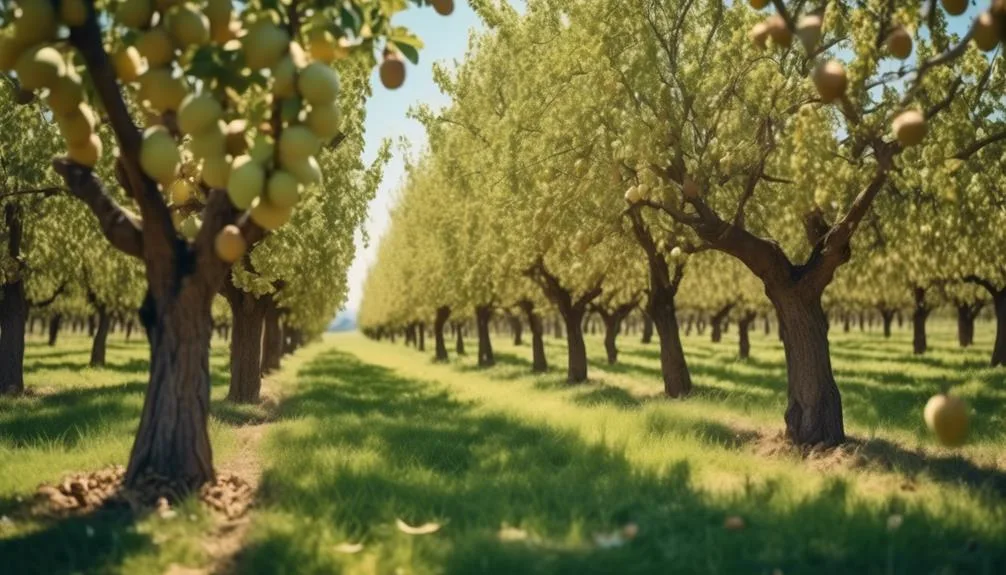If you're thinking about starting a walnut tree orchard, you might be feeling a bit overwhelmed. But don't worry, with the right guidance, you can make it happen.
From finding the right spot to taking care of your trees, it's a big but rewarding project.
So, let's get started on the journey to growing your very own walnut tree orchard.
Key Takeaways
- Conduct soil testing and adjust pH levels to ensure optimal growing conditions for walnut trees.
- Select healthy walnut trees with well-developed root systems and plant them in well-draining soil with full sun exposure.
- Implement regular care practices such as watering, mulching, pruning, and pest control to maintain tree health and productivity.
- Monitor soil health and nutrient levels periodically to make necessary adjustments for optimal orchard growth and productivity.
Selecting the Right Location
When choosing the right location for your walnut tree orchard, consider the specific requirements for optimal growth and production. Start by conducting soil testing to ensure the soil is well-drained and has the proper pH levels for walnut trees. Adequate drainage is crucial as walnut trees don't thrive in waterlogged soil.
Additionally, assess the sun exposure in the area. Walnut trees require full sun for at least six hours a day to produce a healthy harvest. Consider planting on a site that offers protection from strong winds, as excessive wind can damage the trees and reduce productivity.
Preparing the Soil
To prepare the soil for your walnut tree orchard, assess its nutrient levels and structure to ensure it provides a healthy foundation for robust tree growth and bountiful harvests. Begin by conducting soil testing to determine its pH, nutrient content, and organic matter levels. This will guide your fertility management plan, allowing you to make informed decisions about soil amendments and fertilization. Consider the following factors when preparing the soil for your walnut tree orchard:
| Soil Testing | Fertility Management |
|---|---|
| Conduct soil tests to analyze pH, nutrient levels, and organic matter content. | Develop a fertility management plan based on the soil test results. |
| Test for nutrient deficiencies and excesses. | Use organic amendments to improve soil structure and fertility. |
| Adjust soil pH if necessary. | Implement a balanced fertilization schedule to meet the trees' nutritional needs. |
| Monitor soil health regularly through continued testing. | Incorporate cover crops to enhance soil fertility and structure. |
| Re-test soil periodically to ensure optimal nutrient levels. | Utilize mulching to conserve soil moisture and improve overall soil health. |
Choosing and Planting Walnut Trees
Consider selecting young, healthy walnut trees from a reputable nursery with a track record of producing high-quality saplings. Look for trees with well-developed root systems and sturdy trunks.
When planting, choose a location with well-draining soil and full sun exposure. Ensure that the chosen area provides ample space for the trees to reach their full height and spread. Dig a hole large enough to accommodate the tree's root system and backfill with nutrient-rich soil.
Proper spacing between trees is crucial for adequate air circulation and sunlight exposure, which are essential for tree maintenance and optimal nut production.
After planting, provide regular watering, mulching, and occasional pruning to promote healthy growth and improve nut production in the long run.
Caring for Walnut Trees
For healthy walnut trees, ensure regular watering, mulching, and occasional pruning to foster robust growth and maximize nut production.
When it comes to pruning techniques, focus on removing dead or diseased branches to encourage new growth and improve air circulation. Additionally, prune in late winter to early spring to avoid sap bleeding and minimize stress on the trees.
Keep an eye out for pests such as walnut blight, aphids, and codling moths. Implement pest control strategies such as using horticultural oils or insecticidal soaps to control aphids and mites, and applying a copper-based fungicide to manage walnut blight.
Harvesting and Maintenance
When it's time to harvest your walnut trees, carefully inspect the nuts for readiness by checking for the yellowing of hulls and the cracking of shells. Once ready, follow these tips for a successful harvest and to ensure the health of your walnut orchard:
- Pruning Techniques
- Regularly prune your walnut trees to remove dead or diseased branches and promote better air circulation, leading to healthier trees and higher yields.
- Pest Control
- Implement integrated pest management strategies to keep pests at bay, such as using pheromone traps and beneficial insect releases to control pests naturally.
- Regular Maintenance
- Conduct regular maintenance tasks like mulching, watering, and fertilizing to keep your walnut trees healthy and thriving.
Following these tips will help you maintain a productive and healthy walnut orchard.
Conclusion
In your journey to creating a walnut tree orchard, remember that success lies in careful planning, proper care, and ongoing maintenance.
By selecting the right location, preparing the soil, and nurturing your trees, you're setting the stage for a bountiful harvest.
As you continue to watch over your orchard, consider the rewarding process of nurturing and growing your walnut trees, and the satisfaction of enjoying the fruits of your labor for years to come.
Happy growing!

